Native Instruments Maschine+ review: Freedom in a box
Make electronic music without the PC.
It’s been over a decade since Native Instruments introduced the Maschine platform. The dedicated hardware-software combo was an instant hit with users looking for the tactile control of outboard gear with the flexibility (plugins) afforded by a desktop. While this approach made it popular, it soon led many to want something ambitious: a standalone Maschine with the software built-in. It’s finally here, it’s called Maschine+, it costs $1,399 and it’s been on my desk for the last week or two. Is it the all-in-one music production hardware many people (myself included) seek? Maybe, but what I can say for sure is that it’s an impressive, if not a slightly expensive attempt at merging desktop functionality with groovebox-style usability.
For those unfamiliar with Maschine, it’s a little hard to explain what it is without underselling it. You could argue it’s desktop music-making software with a dedicated MIDI controller. But then there are plenty of software-specific controllers like Ableton’s Push or Korg’s MS 20 VST hardware. Maybe you could think of it as outboard gear, but with the UI running on a PC? But that doesn’t quite do the software side of it justice.
Basically, it’s a fully functional creative audio tool, comparable to a DAW, but can also work within other software as a plugin and comes with dedicated hardware, both made by the same company. Unlike most MIDI controllers, there’s an audio interface built-in and it’s all tightly integrated with the software to feel like the two things are one entity. With Maschine+ there’s no need for a PC at all (although you can still work with one if you wish). For this review, I’ll be primarily considering it in its standalone mode. If you currently use Maschine, you already know how it works as a MIDI-software combo. If you haven’t yet, and you’re considering the Maschine+, it’s likely that the standalone feature is what interests you most (and there are plenty of ways to learn about the desktop/PC integration already if you wish).
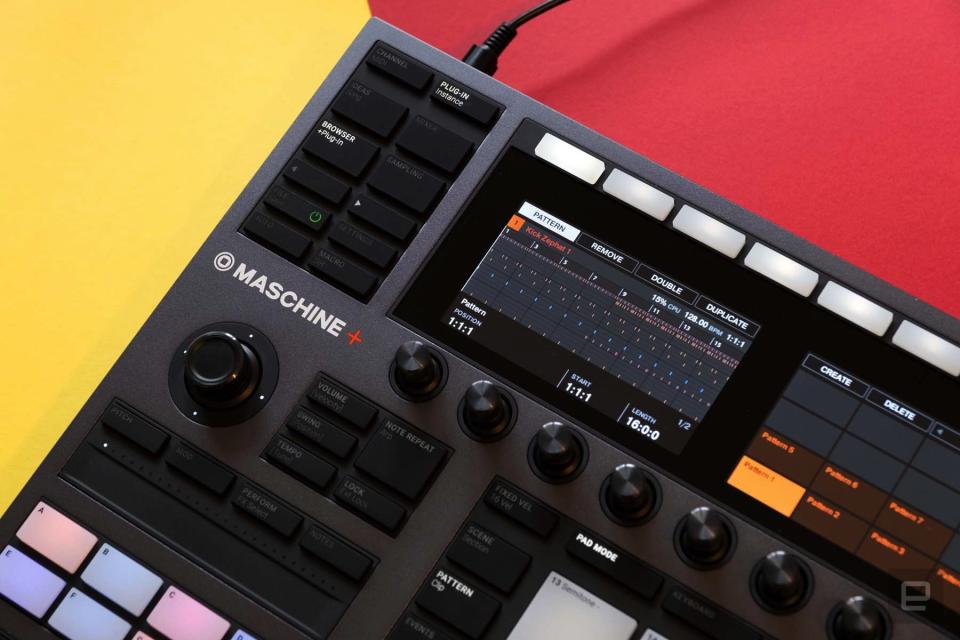
The idea is obvious: Getting rid of the PC is something many electronic musicians want to do. Some feel that clicking a mouse staring at a screen isn't conducive to creativity. Plus, computers can be unpredictable (especially in a live performance). And while I wouldn’t call Maschine+ “portable” in the traditional sense, you can bring this with you on the road and leave your laptop somewhere safe.
Hardware
If you’ve ever seen the Maschine MK3, then the Maschine+ will be familiar. The two are nearly identical, bar the new metal finish and a few minor tweaks to accommodate the necessary computer-free functionality. Even around the back, where all the connections are, there isn’t much of a difference. You still have two inputs and two outputs (1/4-inch TRS), MIDI in and out, a pedal jack and a 1/4-inch headphone port. There are now two USB-A ports (along with the USB-B port for connecting to a PC) which allow you to add other interfaces or MIDI USB gear. Lastly, there’s the all-important SD card slot for storing your projects and samples along with 32GB onboard storage for expansion downloads. NI even includes a 64GB SD card in the box.
The fact that it’s so similar to the MK3 is no bad thing. The third iteration of Maschine provides a logical workspace with high-quality pads and knobs that give it a premium feel — even more so on the plus with its metal housing. The dual displays are still here. Sadly, they’re not touchscreens, though, I think they’re a little small for that to be useful anyway. Also, if you were hoping that Maschine+ could run in standby mode with USB power, you’re out of luck. You’ll need the included power supply for that, though USB power still works for controller mode.
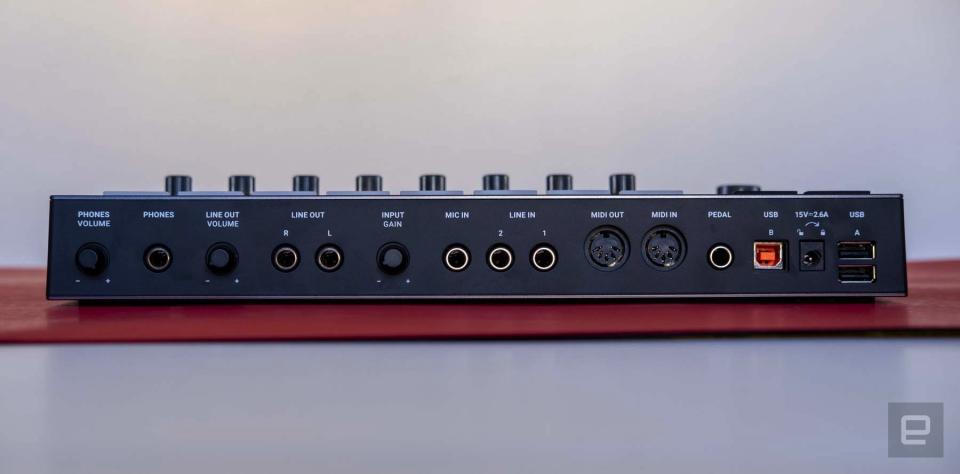
The most important differences in the hardware are the ones you can’t see: the Atom quad-core processor, 4GB of RAM and 32GB of internal storage. It’s these additions that allow the Maschine+ to cut itself free from the PC and run all the software and instruments directly.
This is obviously what makes the Maschine+ interesting. Standalone advanced sequencing hardware can be tricky to get right. Editing single notes, quantizing or any other number of routine tasks you take for granted on a PC can quickly become friction points on badly thought out hardware. And this is where Native Instruments has been shrewd. By waiting, slowly improving the Maschine’s control surface and workflow while it was still tethered to a computer means that most of those pain points have been ironed out. All the company needed to do was give it the processing power, and (in theory) it was standalone ready. Spoiler alert, this is mostly true, too. Though there are still a few tasks where I find myself wishing I had a mouse or keyboard shortcuts.
Synths and sounds
The Maschine software baked into the plus is pretty much what you’d expect if you’ve ever used any of the older controllers with the desktop software. If you’re used to that workflow, you’ll be in familiar territory here. If you’re new to Maschine, then know that it’s a little different to what you might be used to if you primarily work with a conventional DAW. For one, unlike Logic or Ableton Live, there’s no multitrack audio — it’s more about beats, samples and plugins. I’d even say there’s a bit of a learning curve, but that’s typical of all hardware grooveboxes (even the tiny OP-Z took a while to get the hang of).
The big selling point with Maschine+, of course, is not just that it runs the sequencing software inside the box, it’s that you also have access to some of Native Instruments’ best soft synths and effects (VSTs) for the first time in hardware. At launch, the selection of instruments available isn’t exhaustive. In fact, you could say it’s a little sparse, with just seven primary plugins to choose from: Massive, FM8, Monark, Prism, Kontakt, Reaktor and Maschine’s own library.
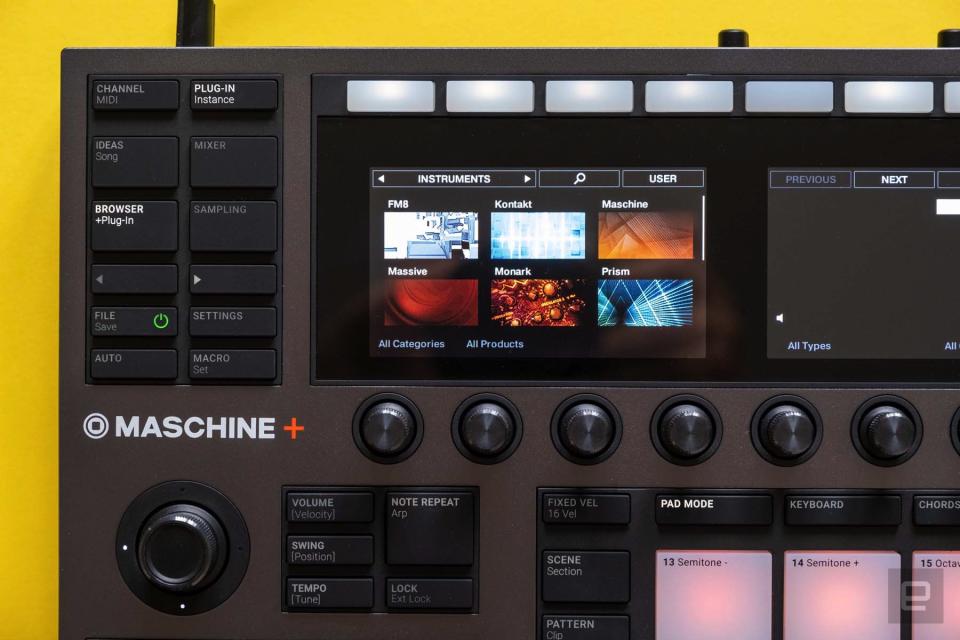
The synths included do cover most bases, with Massive (wavetable), FM8 (FM, obviously), Monark (Analog/subtractive) and Prism (physical modeling/additive) offering most of the primary forms of synthesis. Kontakt obviously is a little more different, given its sample-based nature.
I should also mention that the software instruments that come with the desktop Maschine+ software are also here: Bass synth, the drum engines and a suite of effects.
It’s worth mentioning, you don’t have access to all the parameters you would on a PC. For example, in many of the synths, have too many options to map to the eight physical knob controls, although most things are here as you can “page” through what the knobs relate to. It’s also not currently possible to import any of your own presets for the above synths you may already have (although you can save your sounds in projects etc.).
We also shouldn’t ignore that, as good as most of these instruments are (legendary, even), there’s a lot that isn’t here. I would have loved Massive X, Absynth or Razor to have been included. The better news is that more of NI’s catalog will be coming in the future. But if you were hoping there’d be support for third-party VSTs, then you’re out of luck. A company spokesperson told me “There are currently no plans for 3rd party plugin support.”
Having certain instruments is one thing, but what about the sounds they come with? Of course, you can (and should) make your own, but with the streamlined number of parameter controls, sometimes it’s handy to dip into the presets and find one already in the general direction you want to go as a starting point. Also, using a preset that just leaps out at you is fine, don’t let the musical elite tell you differently. It’s what you do with them that matters.
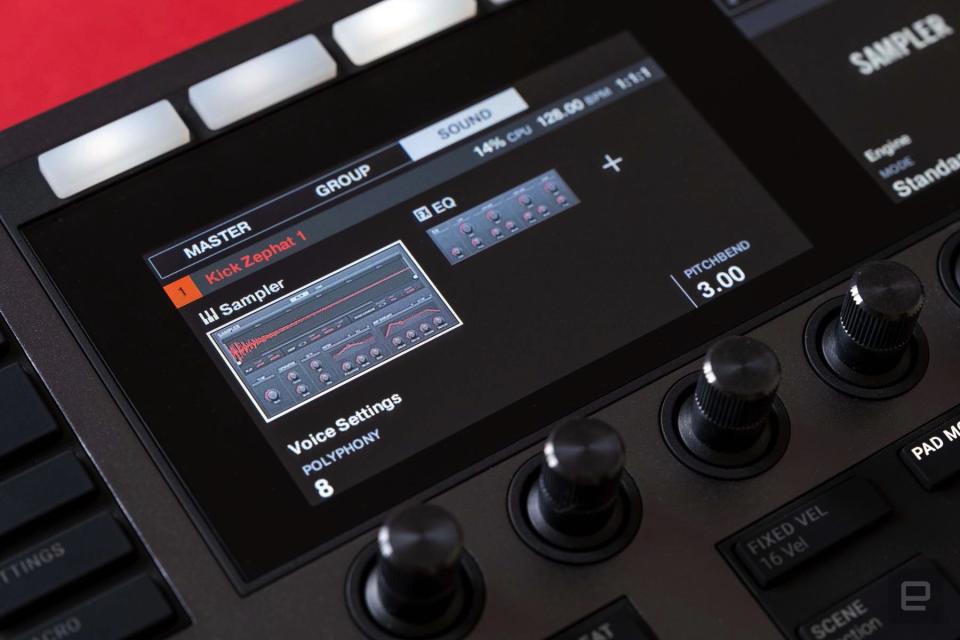
NI has made it pretty easy to hunt down the type of sound you want. If I am working on a bassline, I tend to reach for Massive. Once that’s open I can either browse all the preset sounds one by one, or filter by category, then subcategory and “character”. This really makes sifting through endless (often meaningless) preset names less of a chore.
As for samples, there are a number of expansion packs you can download from day one. These include titles such as Deep Matter and Neon Drive. There’s certainly enough to cover all bases including soul, funk, trance and grime packs among many others. At the time of writing 23 packs in total are on offer. Downloading them is easy (Maschine+ comes with WiFi onboard) and the sounds will be saved to local storage.
As for the kind of sounds on offer, as mentioned, the expansions are pretty varied. As for the presets that come with the synths, they definitely skew electronic. I mean, obviously, but if you’re looking for orchestral strings, or woodwinds, you’ll be less satisfied than if you want saw-tooth leads or sub-bass. Of course, that’s where NI’s rich catalog of samples and expansion packs (or your own samples or created sounds) come in. NI’s library has a particularly strong line of orchestral and analog instruments.
In use
Despite over two decades of meddling with music gear and software, I still find grooveboxes frustrating. (Technically, I wouldn’t call this a groovebox per se, but it’s similar enough in workflow.) With this sort of gear, my brain wants to know how to do everything instantly, without having to trawl through manuals or YouTube tutorials. Maschine+ took me a couple of days to “get.” It’s not that it’s any more complicated than rivals like, say, Akai’s MPC Live 2. It’s just that you have to learn how each section (browsing, sampling, sequencing and so on) works and where certain features are hidden. Unlike desktop software that’s pretty open to different approaches, standalone gear usually has a specific workflow and Maschine+ is no different.
For the most part, know that you’ll be working in “scenes,” which you can think of as “buckets” for sounds — drums in one, lead sounds in another or a group of samples and so on. There are eight buttons that will switch between these “scenes,” each work with the 16 pad grid. That grid can hold a variety of synths, sounds, samples or one-shots on different pads. I prefer to think of it more like you can have eight main musical “ideas” for each track, and then within that, you have a ton of flexibility to make each one as complex as you want (almost).
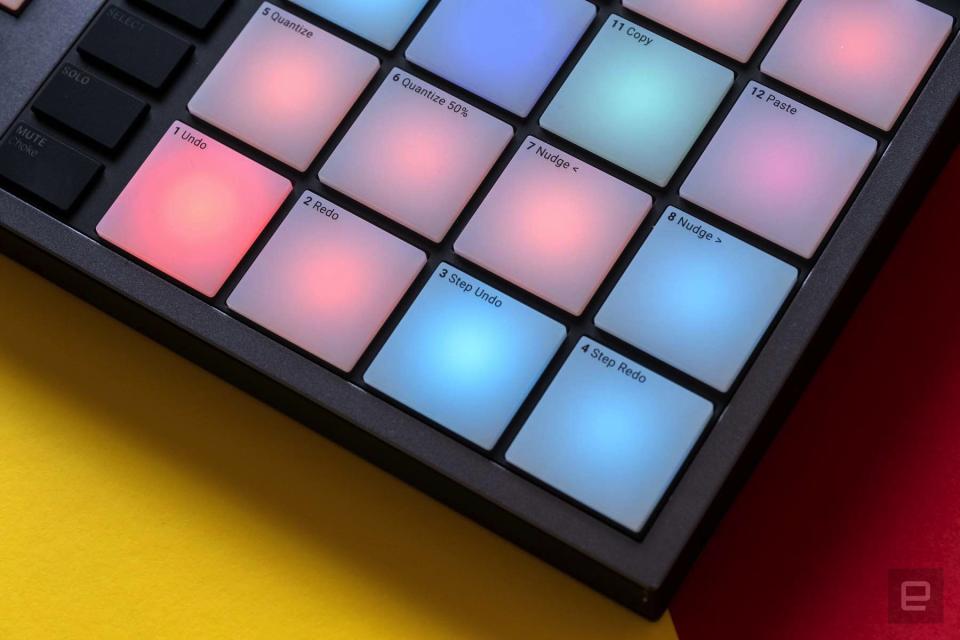
Before you even get to the scenes though, you’ll spend a lot of time in the upper left-hand corner of Maschine+. Here is where you navigate the top-level functionality, such as switching to the browser mode, the current VST instance or the file and settings menus. Below this cluster of buttons is the main navigation rotary. It’s a mix between a game controller D-pad and an endless encoder, which is actually pretty deft at maneuvering through all the menus and screens. Though there were times I was browsing a very long list of presets and accidentally clicked left or right, which goes back one menu level, meaning I’d have to click back in and wind my way through all the presets again. A small complaint, but one worth mentioning.
When you’re in the ideas stage, jumping around the different modes soon becomes second nature. It’s when you move on to building your ideas into something more like a track where I found the learning curve a little steeper.
There’s a button in the top left cluster labeled “ideas.” This section isn’t complex. It reminds me of Ableton Live’s “Session” view. Basically, you create a series of clips in musical sections (say, various drum loop variations, and a few different takes on the bassline etc.) and you can jam with these in different orders to build a track. This workflow is called “Clips” and it actually debuted right here on the Maschine+. It has since been rolled out to all users in the latest 2.12 update to the desktop software.
For me, the challenge was more in the MIDI/note editing view, which is hidden under the Events or Pattern section (one of the function buttons to the left of the main pads). Without a keyboard or a mouse, editing individual MIDI notes is a little more convoluted than simply clicking or dragging. Some tasks, like quantizing out of time notes, have easy to master shortcuts. But if you want to change the note length, for example, it’s a few more button presses and rotary twists to get there. It’s not mind-bendingly hard, and you soon learn the quirks, but it was one of the few times I really missed having a PC.
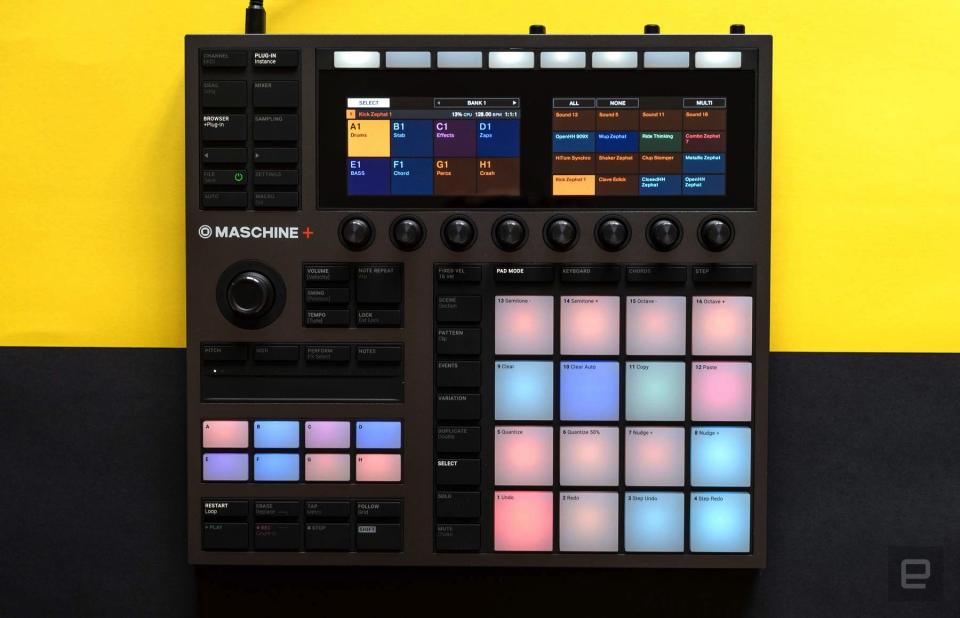
Overall, though, I definitely came away thinking that as much as this is a standalone device, I couldn’t see myself using it to make a complete track. No matter how adept you get at working with the internal sequencer and note editing tools, I would — at the very least — want to bounce things out as stems for a mixdown on the PC. But more likely, I’d want to finish the arranging on the desktop also. Especially for the sort of fine detail like fills and edits at the end of 8- or 16- bar sections. And then for automation and so on.
You 100-percent can do automation on the Maschine+, very easily in fact. But sometimes I just want to get in there with a mouse and tweak the curve manually, rather than “play” it in live, or navigate Maschine’s menus. Lastly, the selection of mixing tools (compressors, EQs and so on), again, isn’t quite as varied as what you will find available for a regular DAW, given the lack of support for VSTs, but everything you need is here — compression, delay, filter, EQ and so on.
Wrap Up
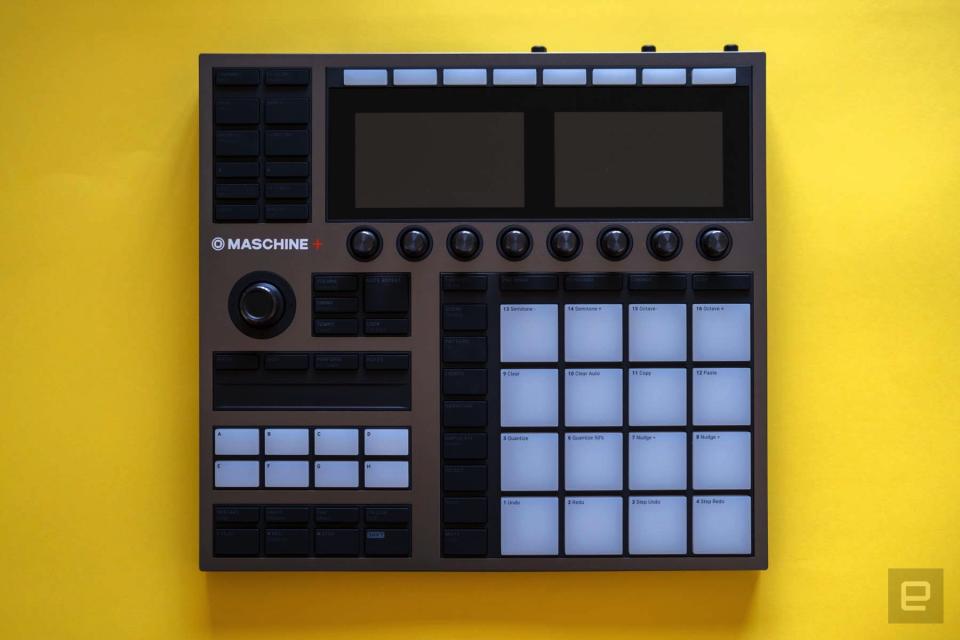
All things considered, the Maschine+ is something of a triumph and an anomaly at the same time. As promised, it’s an all-in-one music making box, with all the strengths that Native Instruments’ hardware and software have to offer. But likewise, it’s lacking the things that NI isn’t so well known for: high quality reverbs, mixing tools and so on. Which then raises another question: Who is this actually for?
If you’re already using Maschine Mk3 for example (currently $649), the only real benefit is the standalone aspect. But at $1,399 that’s a big spend just for the convenience of leaving your laptop out of the equation. If you’re new to production, this is certainly going to allow you to do a bit of everything, and quite well. But if you’re just getting started, you’re better off with a DAW, a simple MIDI controller and some free or more affordable plug-ins.
However, if you’re still using an older Maschine controller and fancy an upgrade, while getting the perks of the standalone features, this might make more sense. Or perhaps you’re just a Maschine fanboy and need to have the best there is. There will, no doubt, be folks who are super excited about this and won’t flinch at the price. It’s just not easy to say it’s good for this group or that type of producer specifically over the Maschine MK3.
Now, I’ve alluded that it’s a little pricey, but for context Akai’s MPC Live 2 is probably the most obvious rival here, and that’s going to set you back $1,200. Both have different strengths but are also trying to appeal to a similar market. The MPC perhaps has a stronger heritage in sampling and performance (it also has more in/outputs — including CV gates). Meanwhile, Native Instruments runs circles around Akai when it comes to synthesis and sounds, and I find the workflow a little more comfortable. So which one will appeal to you will be a matter of personal preference more than budget I suspect.
Groovebox-style gear is always a battle of compromises, and that’s true here. But it’s also hard not to love the Maschine+ and what it represents. Creating electronic music can sometimes feel like filling out a spreadsheet, and Maschine+ not only avoids that. It feels like an actual, bonafide bit of outboard gear… or dare I say, a musical instrument. Anything that encourages you to leave the mouse behind (for the most part) is always going to help you create in a way that’s more musical, more natural, and for that I love it. Let’s just get some of the more recent synths/VSTs on there please!

